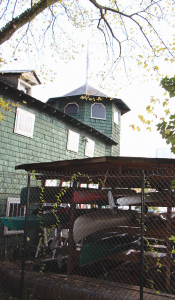
The Washington Canoe Club at 3700 Water St. NW
Two buildings in the Georgetown neighborhood received spots on the 2014 Most Endangered Places list released late last week by the D.C. Preservation League.
The D.C. Preservation League aims to encourage preservation of D.C.’s historic buildings.
“The 2014 list of Most Endangered Places represents some of the challenges that historic resources face in our city. These include proposed excessive and incompatible development that threatens some of our city’s most precious resources; willful demolition by neglect; and financial hardship, which creates obstacles for owners who strive to do the right thing,” Executive Director of the D.C. Preservation League Rebecca Miller said in a press release.
The Washington Canoe Club, located at 3700 Water St. NW, and the West Heating Plant, located at 1051 29th St. NW, both in Georgetown, were designated by the league as endangered, in addition to four other locations across the District: the Anacostia Commercial Corridor, 911 and 913 L Street NW, the Carnegie Library and St. Elizabeth’s East Agricultural Complex.
The D.C. Preservation League includes buildings on the list that are “historically, culturally and architecturally significant,” but have been abandoned or neglected, which could potentially result in alterations or demolitions to the structures. It released the first list in 1996.
The Washington Canoe Club, which also made the list in 2012, is an iconic D.C. site. The boathouse, which is over a hundred years old, is one of only two boathouses remaining in the District.
“This building is a real iconic D.C. image,” Andrew Soles, president of the Washington Canoe Club, said. “You’ll often see it in photographs of Georgetown from across the river. … It’s not the Washington Monument, but it’s an incredibly significant piece of Washington, D.C.”
However, the building has not been renovated since its construction in 1904 and recently has experienced a lack of funding and proper upkeep. The building is structurally unsound, with its windows and roofs requiring either repair or replacement. The National Park Service declared most of the boathouse unfit for occupancy in 2010. Since then, the approximately 200 members of the club have been forced to utilize a portion of the original building that is still operational.
Soles explained that the WCC is currently working on plans to renovate the boathouse to its original state. The renovations are estimated to cost around $5 million and could be completed by 2020.
“It’s going to take more than the efforts of just the 200 Washington Canoe Club members to restore it,” Soles said. “What we’re really hoping is to engage the greater D.C. community who, as I say, see this as an iconic building in the D.C. landscape.”
The other Georgetown building on the list, the West Heating Plant, dates back to the 1940s and provided steam for the District’s federal offices until 2000. The building, a behemoth of brick reaching six stories into the sky, currently sits empty on a prime space of real estate off of the C&O Canal.
The property was sold to a group of developers for $19.5 million in March 2013 and is at risk of being significantly modified to make room for approximately 80 condominiums, expected to be the most expensive condos in the District. However, as the West Heating Plant sits in the historic district of Old Georgetown, the proposal requires the U.S. Commission of Fine Arts to be consulted before alterations can be made.
Additionally, Thomas Luebke, secretary of the U.S. Commission of Fine Arts, pointed to serious structural problems in the building that would likely prevent serious refurbishment or alternations.
“The building has some significant issues in terms of whether it could be preserved or not and to what extent,” Luebke said. “The quandary for redevelopment is, can you use the building which is essentially an enormous box which doesn’t really have floors in it?”
Current plans call for the demolition of more than 65 percent of the building. Only one side of the facade would remain intact during refurbishment while the rest of the building would be taken down to the foundation. Peter Jost, the president of the Foundation for the Preservation of Historic Georgetown, said there would be tension between the preservationists and the realists in terms of what to do with the West Heating Plant.
“There are some preservationists who think nothing should be done to it — it’s beautiful the way it is,” Jost said. “Obviously other people think it should be turned into a usable building. In order to turn it into a usable building it has to go through significant modifications, which I think would change how it looks today. And you have two camps on that. The preservationist or realist realizes that to keep something of the building you have to make some concessions.”
According to Luebke, the Old Georgetown Board will review the issue and issue a report on the structural integrity of the building at a meeting Nov. 6.













